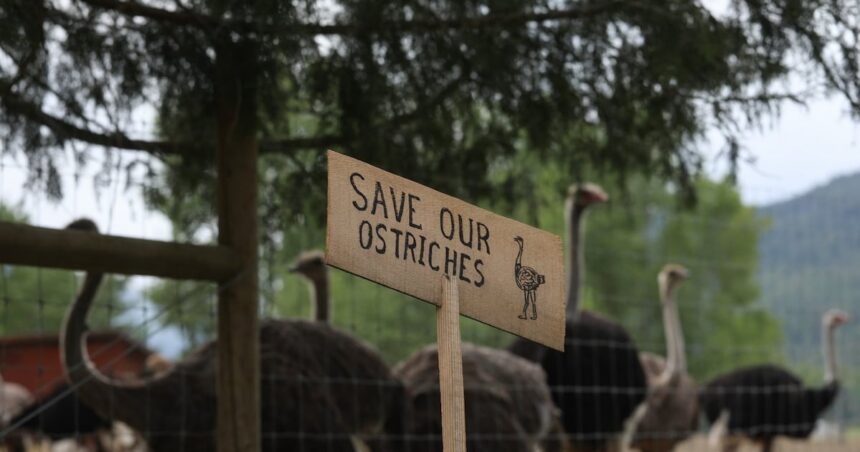As dawn breaks over the rural landscapes of British Columbia, the silhouettes of protest encampments surrounding a controversial ostrich farm have become a fixture in the region’s countryside. What began as a spontaneous gathering has transformed into an organized resistance movement, with demonstrators now constructing semi-permanent structures and establishing supply chains in preparation for what they describe as “the long haul.”
The standoff intensified this weekend when dozens of animal rights activists converged at the farm following the Canadian Food Inspection Agency’s (CFIA) order to cull nearly 300 ostriches after detecting avian influenza in the flock. Protesters maintain that the birds appear healthy and question whether alternative solutions were adequately explored before resorting to mass euthanasia.
“We’re witnessing a pattern of government overreach that prioritizes protocol over compassion,” said Emma Richardson, a spokesperson for the demonstrators. “These birds aren’t showing clinical symptoms, yet officials are determined to implement a blanket solution without considering the unique circumstances of this farm.”
The CFIA has defended its position, citing established disease control protocols designed to prevent the spread of highly pathogenic avian influenza, which poses significant risks to both commercial poultry operations and wild bird populations across the province. Agency representatives emphasized that these measures, while difficult, are necessary to maintain biosecurity standards and protect Canada’s agricultural sector.
“The decision to depopulate an infected premise is never taken lightly,” stated Dr. James Harrington, a senior veterinary officer with the CFIA. “We understand the emotional impact, but must balance this against the potential for widespread disease transmission that could devastate multiple flocks and potentially impact human health.”
Local law enforcement has maintained a presence at the site but has thus far taken a measured approach to the growing encampment. Officers have primarily focused on keeping access roads clear while monitoring the situation for public safety concerns.
The farm’s owners have found themselves caught between regulatory obligations and the passionate advocacy of the protesters. Sources close to the family indicate they are exploring legal options to challenge the cull order, though such proceedings could take weeks to resolve—time the CFIA insists the containment protocols cannot afford.
The standoff has drawn attention from Canada News outlets nationwide, raising questions about agricultural emergency response protocols and animal welfare considerations in disease management scenarios. Environmental activists have joined the original animal rights groups, broadening the coalition’s focus to include criticisms of industrial farming practices.
Community response has been mixed, with some local residents expressing support for the protesters while others voice concerns about potential biosecurity risks that could threaten neighboring agricultural operations. The regional farming association has urged calm while acknowledging the emotional complexity of the situation.
“What we’re seeing is a fundamental clash between bureaucratic risk management and ethical considerations about animal life,” noted Dr. Samantha Chen, an agricultural ethics specialist from the University of British Columbia. “These disputes will likely become more common as our relationship with food systems continues to evolve.”
As the protesters settle in for what could be weeks of demonstration, the situation raises profound questions about how we balance disease control imperatives against growing public concern for animal welfare: In an era of increasing transparency and ethical consciousness, can our agricultural emergency response systems evolve to incorporate both scientific and moral considerations in their protocols?

























